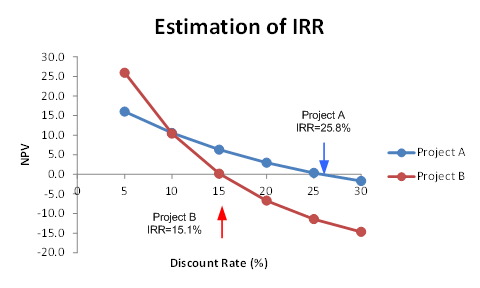First of all we are going to define the concept of NPV and IRR. Then we will see when we should we use NPV or IRR.
1.Net present Value (NPV)
Net Present Value(NPV) is a formula used to determine the present value of an investment by the discounted sum of all cash flows received from the project.
Example
Consider company Shoes For You's who is determining whether they should invest in a new project.
Shoes for You's will expect to invest $500,000 for the development of their new product. The company estimates that the first year cash flow will be $200,000, the second year cash flow will be $300,000, and the third year cash flow to be $200,000. The expected return of 10% is used as the discount rate.
Net Present Value = $80,015.02
If there is more than one project we should choose that one with the highest NPV.
2. Internal Rate of Return (IRR)
Internal rate of return (IRR) is the interest rate at which the net present value of all the cash flows (both positive and negative) from a project or investment equal zero. Or the present value of all the cash flows, equal to the inital investment
Internal rate of return is used to evaluate the attractiveness of a project or investment. If the IRR of a new project exceeds a company’s required rate of return, that project is desirable. If IRR falls below the required rate of return, the project should be rejected.
Example
Assume Company XYZ must decide whether to purchase a piece of factory equipment for $300,000. The equipment would only last three years, but it is expected to generate $150,000 of additional annual profit during those years. Company XYZ also thinks it can sell the equipment for scrap afterward for about $10,000. Using IRR, Company XYZ can determine whether the equipment purchase is a better use of its cash than its other investment options, which should return about 10%.
Here is how the IRR equation looks in this scenario:
0 = -$300,000 + ($150,000)/(1+.2431) + ($150,000)/(1+.2431)2 + ($150,000)/(1+.2431)3 + $10,000/(1+.2431)4
Therefore the rule of thumb is pick the investment if it has a greater IRR than the cost of capital this can be the percentage that we have to pay back for borrowing a loan). If there is more than one project we should choose that one with the highest IRR.
When should we choose NPV instead IRR.
We should choose NPV instead of IRR when there are investment with more than one cash inflows, the absolute size between these projects are very different and these two projects have a different duration.
1. The IRR only works with investments that have an initial cash outflow ( such as the purchase of the investment) followed by one or more cash inflows.
2. The IRR doesn´t measure the absolute size of the investment or the return. For example a $1 investment returning $3 will have a higher IRR than $1 million returning $2 million.
3. The IRR doesn´t consider cost of capital and can´t compare projects with different duration.



























0 comentarios:
Publicar un comentario